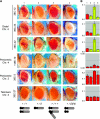A Distinct type of heterochromatin within Drosophila melanogaster chromosome 4
- PMID: 17194780
- PMCID: PMC1840055
- DOI: 10.1534/genetics.106.066407
A Distinct type of heterochromatin within Drosophila melanogaster chromosome 4
Abstract
Studies of transcriptional gene silencing in Drosophila melanogaster suggest that most of chromosome 4 resembles pericentric heterochromatin. However, some modifiers of position-effect variegation, including chromosome 4 dosage and loss of SU(VAR)3-9, have different effects on silencing in pericentric vs. distal arm chromosome 4 heterochromatin, distinguishing these two heterochromatin types.
Figures


References
-
- Ashburner, M., 2004. Position effect variegation, pp. 1007–1038 in Drosophila: A Laboratory Handbook, edited by M. Ashburner, K. Golic and S. W. Hawley. Cold Spring Harbor Laboratory Press, Cold Spring Harbor, NY.
Publication types
MeSH terms
Substances
Grants and funding
LinkOut - more resources
Full Text Sources
Molecular Biology Databases

